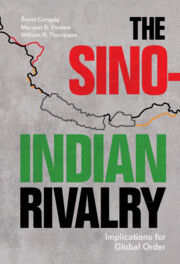Book contents
- The Sino-Indian Rivalry
- The Sino-Indian Rivalry
- Copyright page
- Contents
- Figures and Maps
- Tables
- Acknowledgments
- Part I Introduction
- Part II Spatial and Positional Considerations and Violence
- Chapter 3 The Sino-Indian Rivalry The Positional Dimension (1940s–1950s)
- Chapter 4 Positional Issues and the 1962 Sino-Indian War
- Part III The Evolution of the Rivalry
- Part IV Interconnected Rivalries and Systemic Considerations
- Part V Conclusion
- Bibliography
- Index
Chapter 3 - The Sino-Indian Rivalry The Positional Dimension (1940s–1950s)
from Part II - Spatial and Positional Considerations and Violence
Published online by Cambridge University Press: 15 June 2023
- The Sino-Indian Rivalry
- The Sino-Indian Rivalry
- Copyright page
- Contents
- Figures and Maps
- Tables
- Acknowledgments
- Part I Introduction
- Part II Spatial and Positional Considerations and Violence
- Chapter 3 The Sino-Indian Rivalry The Positional Dimension (1940s–1950s)
- Chapter 4 Positional Issues and the 1962 Sino-Indian War
- Part III The Evolution of the Rivalry
- Part IV Interconnected Rivalries and Systemic Considerations
- Part V Conclusion
- Bibliography
- Index
Summary
Given China and India’s claims to Asian leadership, the positional dimension of the Sino-Indian rivalry was central to their relationship in the 1940s and the 1950s. This positional contest played out in three venues: (i) in various Asian multilateral fora (such as the 1947 Asian Relations Conference and the 1955 Bandung Conference) and in India’s attempts to mediate in conflicts involving China and other players; (ii) in the Himalayan states (Nepal, Bhutan, and Sikkim) and in Southeast Asia; and (iii) in Tibet. The Tibet issue was particularly fraught with strategic consequences. As China sought India’s help to consolidate its own rule in Tibet, it gave India an exalted but much-resented position in China’s internal affairs (pertaining to Tibet). Matters related to Tibet also entangled the positional and spatial dimensions of the Sino-Indian rivalry because the territories in dispute between China and India had complex historical links with Tibet.
Keywords
- Type
- Chapter
- Information
- The Sino-Indian RivalryImplications for Global Order, pp. 47 - 74Publisher: Cambridge University PressPrint publication year: 2023



